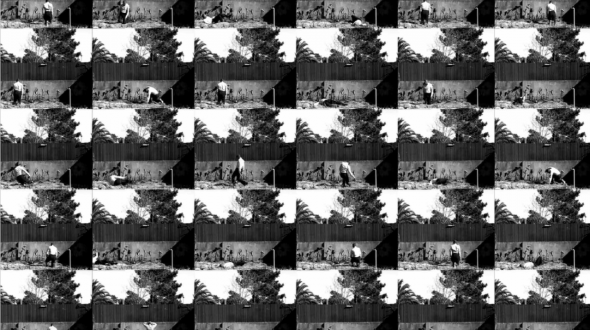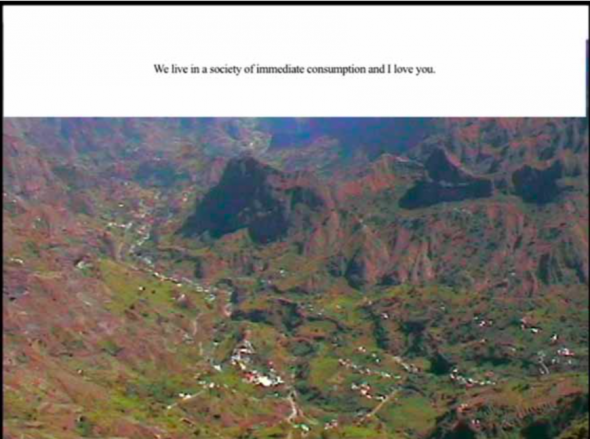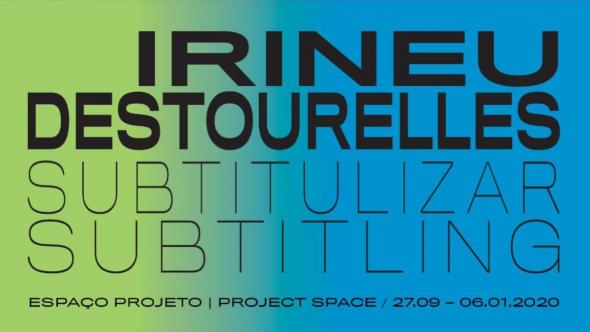I am not here. I am here Notes on an accidental body-place
In 2003, in one of his first works, published in the catalogue of the MA Fine Art Degree graduate exhibition of Central Saint Martin’s College of Art and Design, entitled Silence and Camouflage, Irineu Destourelles, who at the time still authored his works with the name Irineu Rocha, wrote: ‘And somehow I feel that I am not here, yet I have to be here and therefore I am expected to ensure this game’. An excerpt of a written work where the artist presents one of the two key elements of his artistic positions and working process: body and place, in a tensional and dialogical relationship. A place that here is simultaneously real (physical, social, historical), mental (imagined) and psychological (projected and secret), a reconstituted place - an in-between. A place that is almost unspeakable. This place is difficult, almost impossible to inhabit, to receive and enact a body in the making, here the body of the artist, which is simultaneously - and in place of the work - author, narrator, and persona (character). In a seminal moment of his artistic career, Destourelles thus designates a space for the performativity of a Self, of a subjectivity constructed with/by the desire of the Other. This is a ‘game’ for which Destourelles uses writing and images, alternately or together, the majority captured on camera, recomposed and re-edited in videos, one of the most effective and recurrent mediums (and stages) of his production.
 Paisagem Ex-Colonial com Diferentes Filtros, 2019
Paisagem Ex-Colonial com Diferentes Filtros, 2019
In 2014, the artist used the field of authorship itself to create another persona, Irineu Destourelles, with which he began to sign his works. Ten years after Silence and Camouflage, the artist incorporated and performed, divided and reconstituted, in the space of authorship itself, a story experienced in the first person and an extensive collective history of 500 years, which began with colonial occupation and exploitation, specifically in African territories. The artist uses a symbolic and remarkable episode from this collective history, in the character Clémence Destourelles (Fort-de-France 1816 - Paris 1910), a Creole woman from Martinique and wife of Arthur Gobineau, author of Essai sur l’inégalité des Races, published in 1853. This essay is considered to be one of the foundational texts of the process of institutionalisation and naturalisation of the concepts of race and racism, for the discursive construction of an ideology of domination that justifies and perpetuates ‘the dehumanisation, expropriation and exploitation of non-Europeans’. Irineu Destourelles produces an effect of camouflage that recalls historical processes of creolisation and ‘inter-racial’ relations, representing a violent and ‘pathological’ historical real, that of colonialism, but also that of decoloniality.

The same year, Irineu Destourelles produced New Words for Mindelo’s Urban Creole, one of his first videos, where, using writing as the only visual element, the artist questions language and languages in the process of perpetuation of the colonial discourse in the post-colonial context. Breaking the silence, Destourelles constructs a corpus of new words, by combining Latin and Cape Verdean Creole, to name and give visibility to the colonial legacy’s social structures of power. This corpus is also a critical and poetic reflection on his personal experience of the diaspora, an experience that takes place in between languages and places. Born in Cape Verde (Santo Antão) in 1974, leaving for Portugal with his family at the age of four, Destourelles would return to Cape Verde for the first time between 2009 and 2012, to live and work.
This return to Cape Verde gave rise to another work, the video Ex-colonial Landscape with Different Filters, 2019, one of four new videos conceived specifically for the exhibition, which combines writing and image. The work is the first in the exhibition and presents itself as one of the possible declensions of the title of the project: Subtitulizar [Subtitling]. This title refers to an action, the ‘making’ of subtitles, the verb form of the noun ‘subtitle’, a neologism in Portuguese created by the artist, which evokes the habitual presence of Portuguese subtitles in foreign films, on television and in the cinema, a nostalgic memory of childhood. This constant presence of subtitles together with images expands the relationship between the image and the spoken text, between signified and signifier, in other words, it suspends established binary relationships, proposing a ‘third text’ in this relationship between the film and the viewer. This action is also one of constant translation, negotiating between two languages, a difficult negotiation between linguistic and cultural structures, which the artist compares to the social and cultural negotiation of individuals of the diaspora and which endures within communities of the diaspora themselves, between different generations.
Produced using films made in 2009, at the time of the artist’s return to Santo Antão, Ex-colonial Landscape with Different Filters presents the Ribeira do Paul Valley in an image that the stationary camera captures continuously and whose movement comes from the constant application of bright colour filters, subjecting the image to a process of abstraction, mutation, and sometimes near erasure: a ghost image. Colour, or its absence, here as in the artist’s other works, introduces a poetic and political element, a colour that could fill spaces with the strength of (re)imagining the place where the absent body could finally establish itself. This landscape is also intersected by the continuum of history, an ‘ex’ that links past to present. A landscape that, like bodies – black bodies –, is inscribed in the colonial history that still determines its present condition. The text, which runs along the top of the image, comes from the combination of excerpts of lyrics of Portuguese pop-rock songs from the 1980s, sung in Portuguese, and quotes from Jonas Savimbi and José Eduardo dos Santos during the war years in Angola. In the space of writing, Destourelles collects and reorganises words of love and war, rooted in the construction of identity – post-revolutionary Portugal at the time of its integration into ‘capitalist democratic Europe’ and post-independence Angola, immersed in a civil war. The text, which Destourelles translates and only presents in English, juxtaposes these two parallel but foreign worlds, that the television of his childhood brings together with the images of a distant war in Angola, a war also spoken in Portuguese.
Bodies appear in Several Ways of Falling Ordered Differently, 2019, a mosaic video, in black and white, where we see the artist’s body repeatedly falling, in different ways, before the viewer – from the front and from behind. Destourelles films himself in his father’s vegetable garden, a safe but closed domestic space, where his father tries to recreate and establish a landscape from his native land, planting yams and sugarcane. A vegetable garden suspended between his land of origin and adoptive land, a place of cultivation that also determines a space of work, alluding to a certain gender performativity projected onto the black male body. The body is in a back yard, facing a wall, beyond which we can only catch a glimpse of the public space outside. The images of the fall are shown in slow motion, a fall that the artist wants to be staged and controlled. A falling body but also a body that resists, determining the conditions of its own fall. These images of black bodies falling and lying on the ground resemble images of shootings, of mise-à-mort (it is impossible not to think of Francisco Goya’s representations in The Third of May 1808 or The Disasters of War). In this work, Destourelles evokes a muffled everyday violence that afflicts Africans and Afro-descendants of the diaspora, a state of violence on the psyche - the construction and projection of an I that is always an Other -, but also a real violence, in other words, a ‘structural overexposure to social and political violence’ of black bodies, subject to a constant ‘contamination of Life by Death’.

Death looms in One Hundred and Two Houses on Fire, 2019, a video in black and white, featuring 102 successive drawings of houses in flames that evoke memories of an Africa consuming itself, at the same time revealing the instability of the concept of home ‘that for me, as a subject of the diaspora, is a complex topic’. The houses are burning from the inside, in internal combustion, a process of violent destruction, interior and chaotic, something close to the experience of trauma. Destourelles draws the houses, with a ballpoint pen and markers, forming the geometric outlines that construct the walls, the closed doors and windows, and the patches of black smoke in obsessive arabesques that at times appear to engulf the houses. They are like bunkers or prisons, cold and isolated, occupying the edges of the image, in the middle of desolate, angular and inhospitable landscapes. Like in previous works, the artist uses quantification - 102 houses, different filters, various ways of falling – a process of abstraction that introduces an element of distancing, against any hint of seduction: this is an exercise of translation and not identification. Faced with images, faced with pain, we are almost always foreigners. Silence establishes itself once more.
The theme of home returns in Supernatural Forces, Mental Health and Detail from Indoors, 2019, the last of the four videos produced for the project Subtitulizar. Destourelles uses the stationary camera to film a detail inside a house, the house of his mother. He films an arrangement of colourful plastic flowers that the image turns black and white. Over this image, whose movement is almost imperceptible, the artist applies a white filter, producing a menacing effect of near erasure. The inside of a house that alludes ‘to what I interpreted in my youth as my mother’s obsession with plastic flowers and furnishings in her attempt to create a perfect domestic environment as a refuge from a sometimes hostile social context’. The house here is a domestic space of confinement, but also of reinvention, reminiscent of the feminist theories and artistic practices of the 1970s. Once again, the focus of the work is the violent experience of the diaspora vis-à-vis linguistic, cultural and geographic duality, accompanied by a sensation of loss (of falling), difference and opposition. Writing appears with images again, in a text inspired by an anonymous academic essay on attitudes to mental illness in Cape Verde, where the author seems to confuse the Portuguese and Cape Verdean contexts. Pathological states such as ‘land disease’, ‘tired head disease’ and even ‘disease caused by the hand’ allude to the states of anxiety, instability and vulnerability suffered by these communities, but also the loss of location in relation to the cultural and geographical space occupied by the subjects. They also convey the state of intense negotiation that exists between ‘negative supernatural forces’ and unequal social and political structures, in a place halfway between the land of origin and the land of arrival.
Irineu Destourelles studied at the Willem de Kooning Akademie, Rotterdam, and at the Central St. Martin’s College of Art and Design, London. His work has been exhibited at Casa África, Las Palmas and the Fondazione Giorgio Cini, Venice, and projected at ICA, London, Transmediale, Berlin, Hangar Bicocca, Milan, and Espaço Transversal of ArtRio 2017, among others. He currently lives and works between Edinburgh and London.